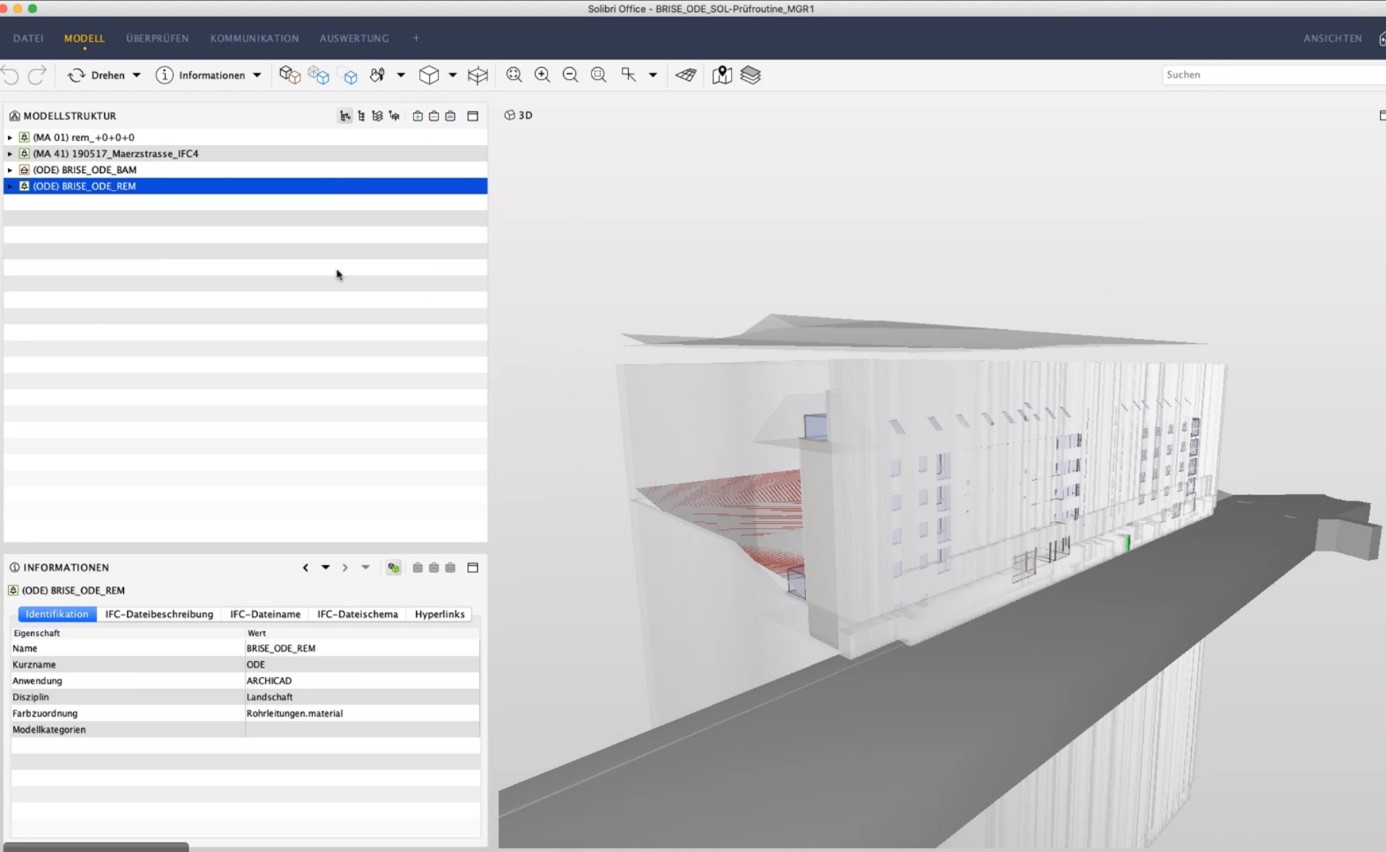BRISE-Vienna: The automated 3D reference model as municipal verification tool

A big part of public admission processes consists in checking and verifying proposals and requests upon their correctness and eligibility – we could say: verification and issuing of permissions are key tasks of the public sector.
In the case of issuing building permissions, a big deal of this process consists in verifying, whether the investor or / and the planner propose a building that is in line with the manifold building requirements of public authorities. Does it leave enough space to the neighbouring property? Is it within the limits of the maximum height? Does it come with a green roof? Do emergency exits and escape routes exist in the required amount and with adequate spatial dimensions? Have enough fire extinguishers been planned etc.? Architects have long lists to comply with before a building can receive a permission by the municipal planning authority.
Checking paper plans for all these requirements has been an arduous and time-consuming exercise in the past – and it still is in virtually all growing cities. Imagine having to make sense of different floor plans, technical drawings and sectional views for a proposed building and deciding whether all requirements have been met. Especially if you need to consider variables like
- In which part of the city is the building located?
- What special regulations have been agreed upon for this district or street?
- How much do new regulations differ from the older ones that were valid before?
- Which recent – or not so recent – court decisions have been made that affect the proposed building?
No wonder it often takes a long time until a public official can show green light for a proposed building project.
With the Automated Reference Building Model (REM) the City of Vienna is working on a solution that will dramatically change the way how municipal planning authorities work in the future. In its ideal version, the REM is making use of the full potential of building information modelling (BIM) to automize a key verification process in urban development.
How does this function? And what is the magic sauce that makes it work?
It is a rather technical process, but it is worth understanding it, since it helps other cities replicate the Vienna approach – and it teaches us some important lessons on how to digitize public services in general. So, let us try to break it down into the core elements:
At the beginning of each planning process for a new building there is a detailed measurement plan of the site (VMP). It is produced by the planner as a DWG file and consists of a 2.5D map. 2.5D in this case means that the map has geometrical information in form of lines – e.g. on the shape of the site, the sidewalk, etc. - and alphanumeric information (e.g. length, height, depth etc. of the site). This DWG file is machine readable and can be translated into a 3D Model of a reference building by a special software. In the case of Vienna, researchers are using FME as the tool to perform this task.
For FME to be able to correctly associate the details from the plan into the 3D reference model, two steps of translation are necessary:
- For producing the VMP in a machine-readable way in the first place, the planner needs to follow a certain standard for naming the different layers. The city of Vienna provides this standard as a plugin to the planner’s software, which needs to be downloaded from the Wien.gv website.
- The researchers need to produce a mapping table (once) which serves as a reference to translate the different levels of detail into the 3D model. These then become the rules of modelling according to which the REM is produced automatically.
Besides the information from the 2.5D measurement plan, the reference model must integrate additional information which is given by the planning authority as text within the development plan of the city or the specific zone. This is, where AI needs to come in. A semantic analysis of the relevant documents helps to extract the necessary additional information and integrate it into the REM in an automated way. This could be, e.g. the minimum ceiling height, the maximum distance between rooftop and building height, requirements for gardens or underground objects, etc. A feasibility study by the City of Vienna and Data scientists from Cloudflight produced 12 use cases of textual provisions, which can be accurately detected by an AI.
These provisions are uploaded to FME in parallel to the map (DWG file) as .json or .xml file. A rather complex modelling process then reads all information provided and transfers them into an IFC file, which is the standard open file format used by Building Information Modeling (BIM).
With this model, the planning authority now has a powerful tool to start a verification of the 3D building model provided by the planner. Most of this is done by automated checking routines, accompanied by some manually assisted verification. We will look at this process in more detail in a separate article. Figure 1 shows the IFC model as a result of the automated modelling process.
Figure 1: Visual representation of the 3D Reference Model[1]

The automated production of a 3D reference model serves as a great example for digitization of public services. Although it is a specific project, there are a few general lessons to be learned from this process:
Digitizing public services follows the same cost-benefit ration as investments in infrastructure
The development of the technology and the modelling process requires detailed work over a long period of time. The AI needs to be trained, a translation map has to be developed manually and the standard for naming the layers has to be provided to the planners. These are high upfront costs which require significant investments. This process, however, needs to be done only once. After establishing a functioning digital process, it can be repeated and replicated any number of times – and it will save time and effort every time it is executed. The upfront costs thus pay back multiple times over a long period of time!
Highly specialized knowledge is necessary to create digital public services
BRISE-Vienna builds on BIM, AI and Augmented Reality. Highly specialized experts in each field need to come together to develop the required solution. This places high demands on coordination and project management to keep the overview over the progress of the technical details, to link all elements in a senseful way and to keep the goal in focus. At the same time a plan needs to be designed for extracting the specialized knowledge, which resides in the final product, from the individual experts and provide it in a way that minimizes dependence on single individuals.
Digitizing public services requires thorough training and coaching
Once BRISE-Vienna is successfully finalized, the planning authority will adopt the automated verification process as a key tool within their daily routine. The municipal workers at the planning authority will need intensive and ongoing training to be able to deploy the software, but – even more – to understand the possibilities and limits that come along with it.
[1] Source: ODE office for digital engineering - Krischmann, T.; Urban, H.; Schranz, C.: „Entwicklung eines openBIM-Bewilligungsverfahrens“ In: Bauingenieur (2020), Heft 9, S. 335–344.“
About this resource
The Urban Innovative Actions (UIA) is a European Union initiative that provided funding to urban areas across Europe to test new and unproven solutions to urban challenges. The initiative had a total ERDF budget of €372 million for 2014-2020.
Similar content




